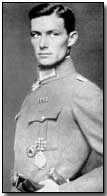Who's Who - Joseph Veltjens
 Joseph Veltjens (1894-1943)
scored 35 victories as a leading German
air ace of
the First World War.
Joseph Veltjens (1894-1943)
scored 35 victories as a leading German
air ace of
the First World War.
Born in Geldern on 2 June 1894 Veltjens was prompt in enlisting with the German Army with the outbreak of war in August 1914, joining the Kaiserin Augusta Guards Regiment Nr. 4 on 3 August.
At the close of the following year, then aged 21, he sought and requested a transfer to the burgeoning German air service; after gaining his pilot's license in December 1915 he was posted to FA23 in May 1916, initially charged with reconnaissance duties.
In March the following year Veltjens (nicknamed 'Seppl'), posted to Jasta 14 and by now flying with his trademark barbed arrow painted along his aircraft's fuselage, was permitted to assume combat missions. August 1917 brought him a transfer to Jasta 18 with some five victories under his belt; he was to improve this tally to 10 while with Jasta 18.
The following March Veltjens joined Jasta 15, taking command of the squadron in mid-May - the same month he received the Knight's Cross with Swords of the Order of the House of Hohenzollern and the Iron Cross (1st Class). Within three months the even more prestigious Pour le Merite followed.
Ending the war with 35 confirmed victories in total, Veltjens was to see further action during the Second World War, serving as Herman Goering's emissary to Finland in 1940 with the rank of Lieutenant Colonel.
He was killed in an aircraft accident - the 'plane on which he was travelling flew into the side of a mountain while trying to evade pursuing British fighter aircraft - on 6 October 1943 while en route to Rome, again on behalf of Goering, this time destined for a visit to Mussolini.
A howitzer is any short cannon that delivers its shells in a high trajectory. The word is derived from an old German word for "catapult".
- Did you know?
